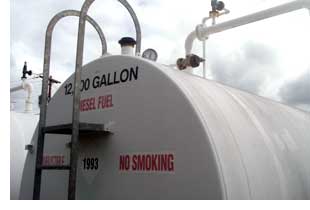Oil Spill Prevention:
 Most
oil spills are small and preventable and many are accidental. Therefore, it is important to educate the community about small spills
as well as preparing plans and staging equipment for potential large spills. Being prepared for potential oil spills in your
community can prevent costly cleanups by minimizing the release. Preparedness can include many things such as community education,
surveys of tanks and other storage areas, staging oil spill response equipment, and developing environmental sensitivity maps,
local knowledge guides, and area contingency plans.
Most
oil spills are small and preventable and many are accidental. Therefore, it is important to educate the community about small spills
as well as preparing plans and staging equipment for potential large spills. Being prepared for potential oil spills in your
community can prevent costly cleanups by minimizing the release. Preparedness can include many things such as community education,
surveys of tanks and other storage areas, staging oil spill response equipment, and developing environmental sensitivity maps,
local knowledge guides, and area contingency plans.Oil Pollution Prevention regulation requires
- specific non-transportation-related facilities to develop and implement Spill Prevention, Control, and Countermeasure (SPCC) plans to prevent oil discharges to navigable waters and adjoining shorelines, and
- some oil storage facilities to prepare Facility Response Plans, plans to respond to a worst-case discharge of oil and to a substantial threat of such a discharge.
The National Oil and Hazardous Substances Pollution Contingency Plan, more commonly called the National Contingency Plan or NCP, is the federal government's blueprint for responding to both oil spills and hazardous substance releases. The National Contingency Plan is the result of our country's efforts to develop a national response capability and promote overall coordination among the hierarchy of responders and contingency plans.
Workers must be trained to the HIGHEST LEVEL of responsibility that they may be assigned in response to a spill. Please go to the following link for more detail on emergency response training requirements: Hazardous Waste and Emergency Response Training Requirements
Contaminants of Concern:
Contaminants of concern are based on the type of substance, usually a liquid, being stored in the UST. Petroleum products (e.g., motor fuels, petroleum solvents, heating oil, lubricants, used oil) consist of the majority of UST's, however any number of hazardous substances may also be stored in UST's. Common contaminants of concern for petroleum substances include:- Hydrocarbons
- BTEX (benzene, toluene, ethylbenzene, and xylene)
- methyl tert-butyl ether (MTBE)
- lead
Any oil spill can pose a serious threat to human health and the environment, requires remediation that extends beyond your facility's boundary, and results in substantial cleanup costs. Even a small spill can have a serious impact. A single pint of oil released into the water can cover one acre of water surface area and can seriously damage an aquatic habitat. A spill of only one gallon of oil can contaminate a million gallons of water.
Implementing Solutions:
Please submit your experiences (successes/challenges) and tribal-specific documents to share on our website using the attached form.Download Form
Resources:
This fact sheet focuses on the management of facilities with ASTs to prevent contamination of drinking water sources (ground water and surface water used as public drinking water supplies).EPA's Managing Above Ground Storage Tanks to Prevent Contamination of Drinking Water [pdf]
Alaska Department of Environmental Conservation AST Operator Handbook [pdf]
Websites:
ENational Response System (NRS) ? The designated federal point of contact for reporting all oil, chemical, radiological, biological and etiological discharges into the environment, anywhere in the United States and its territories:www.epa.gov/emergency-response/national-response-system
EPA's Facility Response Plan (FRP) Overview (Rule Summary, Rule History, Additional Information):
www.epa.gov/oil-spills-prevention-and-preparedness-regulations/facility-response-plan-frp-overview
EPA's Spill Prevention, Control, and Countermeasure (SPCC) Rule:
www.epa.gov/emergencies/content/spcc/index.htm
EPA's Overview of the Spill Prevention, Control, and Countermeasure (SPCC) Regulation:
www.epa.gov/oil-spills-prevention-and-preparedness-regulations/overview-spill-prevention-control-and
Oil Spills Prevention and Preparedness Regulations:
www.epa.gov/oil-spills-prevention-and-preparedness-regulations
Related Pages:
Aboveground Storage TanksBrownfields
Contaminated Sites
Federal Facilities
Underground Storage Tanks
For more information, please contact:
Jennifer Williams, Alaska Program Coordinator, Sr.
Tel: 928/523-0673
Email: Jennifer.Williams@nau.edu
Tel: 928/523-0673
Email: Jennifer.Williams@nau.edu
Last updated: July 10, 2015
